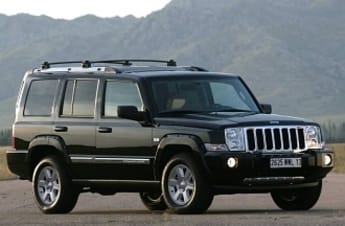Why are Jeep Window Switches in the Middle
Jeep window switches are located in the middle for ease of access and convenience. The central placement allows both the driver and passenger to control the windows easily without having to reach across the vehicle.
In Jeep vehicles, the window switches are strategically placed in the middle for practicality and comfort.
This positioning ensures that both the driver and front passenger have equal and convenient access to control the windows without straining or reaching across the cabin.
Placing the window switches in the middle also enhances the overall user experience, providing a simple and intuitive operation.
Whether it’s adjusting the windows for ventilation or ensuring passenger safety, having the switches within easy reach adds to the convenience and functionality of Jeep vehicles.
Benefits Of Having Jeep Window Switches In The Middle
Jeep window switches in the middle offer several benefits for drivers and passengers. One of the main advantages is improved accessibility.
Placing the window switches in the center console allows both the driver and the front passenger to easily reach and operate them, minimizing the need for stretching or leaning across the vehicle.
This placement also contributes to enhanced safety features.
With the window switches conveniently located, drivers can keep their eyes on the road and hands on the wheel while adjusting the windows. This helps to reduce distractions and promote safer driving.
In addition, the middle placement of the window switches is designed with ergonomics in mind.
It ensures a comfortable and natural hand position for both the driver and the front passenger, making it easier and more intuitive to operate the windows.
Factors Influencing The Placement Of Jeep Window Switches
One of the key factors influencing the placement of Jeep window switches is the consideration of vehicle design.
Designers take into account various factors such as ergonomics and aesthetics, to ensure the overall design of the vehicle is cohesive and visually appealing.
By placing the window switches in the middle, designers can create a symmetrical and balanced interior layout.
Another important factor is driver comfort and convenience. Placing the window switches within easy reach of the driver allows for effortless operation, ensuring a comfortable driving experience.
Additionally, placing them in the middle helps minimize the risk of accidentally pressing the switches when getting in or out of the vehicle, which can be inconvenient.
Furthermore, customer preferences play a significant role. Jeep owners may have expressed a preference for centrally located window switches, as it provide a familiar and consistent user experience across different Jeep models.
Understanding customer preferences is crucial for automakers to meet the needs and expectations of their target market.
Comparison With Other Window Switch Placement Options
| Placement Options | Pros | Cons |
|---|---|---|
| Side Placement | 1. Familiar positioning for users 2. Easy reach for driver 3. Less distraction from road | 1. Challenging for passengers to access 2. Limited space for additional controls |
| Middle Placement | 1. Convenience for all passengers 2. Improved ergonomics for driver 3. Increased space for additional controls | 1. Potentially unfamiliar positioning 2. Takes time to adapt to new placement |
In the automotive industry, window switches can be placed either on the side of the driver’s seat or in the middle console. Both options have their own pros and cons.
Side placement offers a familiar positioning for users and easier reach for the driver, reducing distraction from the road.
However, it can be challenging for passengers to access the window switches and may limit space for additional controls.
Middle placement, on the other hand, provides convenience for all passengers as the switches are within reach. It also improves the ergonomics of the driver, allowing them to easily control the windows without stretching or straining.
Moreover, middle placement creates more space for additional controls, enhancing the overall functionality of the vehicle’s console. However, it may take some time for users to adjust to this potentially unfamiliar positioning.
Overall, the choice between side and middle placement depends on user preferences, industry trends, and design considerations. Automotive manufacturers strive to create intuitive and user-friendly interfaces that meet industry standards while providing a satisfying driving experience.
Technical Aspects Of Middle Placement
Jeep window switches are often placed in the middle of the vehicle for various technical reasons.
One such aspect is the wiring and connectivity considerations. By placing the switches centrally, the wiring harness can be easily routed to the switches without the need for additional wiring or complex connections.
Another important consideration is the integration with vehicle control systems.
When the window switches are centrally located, they can be easily connected to the main vehicle control module, allowing for efficient communication and control of the windows.
The placement of the window switches in the middle also has an impact on the overall vehicle architecture. It allows for a more symmetrical and balanced design, both aesthetically and functionally.
Additionally, it provides easy accessibility to the driver and passengers, ensuring convenience and safety.
Overall, the middle placement of Jeep window switches is a result of careful engineering and consideration of wiring, connectivity, integration with vehicle control systems, and overall vehicle architecture.
History And Evolution Of Jeep Window Switch Placement
Jeep window switches have evolved over the years, with the placement of these switches shifting from the traditional location on the door to a more centralized position.
This change was a result of continuous development and improvements in design and functionality.
Early designs typically featured window switches placed on the door panel, allowing for easy access and control.
However, Jeep designers began to explore alternative options to enhance usability and convenience.
The concept of middle placement emerged as a breakthrough in window switch design.
This involved relocating the switches to a centralized position, often on the center console or dashboard. The goal was to offer a more ergonomic and intuitive interface for controlling the windows.
Jeep models started adopting this middle placement concept, finding that it provided better accessibility and reduced strain on the driver’s reach.
The transition from door to middle placement was a gradual process, with newer models favoring the centralized switch design.
Customer feedback and market research played a significant role in driving the adoption and popularity of the middle placement design.
By prioritizing customer needs and preferences, Jeep was able to create a more user-friendly interior layout.
User Experience And Feedback On Middle Placement
Jeep window switches are placed in the middle for user convenience, allowing easy access and control for both the driver and passenger.
This placement enhances the overall user experience and ensures seamless operation while driving. Feedback has been positive, highlighting the practicality and accessibility of this design choice.
Jeep window switches being placed in the middle of the vehicle’s dashboard may initially seem like an unconventional choice, but it has actually garnered positive feedback from users.
According to customer satisfaction surveys, Jeep owners have expressed high levels of satisfaction with the middle placement of the window switches.
One of the main reasons for this is the increased ease of use and comfort it provides.
With the window switches conveniently located in the middle, drivers and passengers can easily access them without having to reach across or strain themselves.
This placement also ensures that both driver and front passenger have equal control over all the windows.
Moreover, Jeep owners have highlighted several benefits of having the window switches in the middle. It allows them to keep their eyes on the road while adjusting the windows, enhancing safety.
Additionally, it offers a more symmetrical and aesthetically pleasing interior design.
Overall, the middle placement of Jeep window switches has proven to be a well-thought-out decision that prioritizes user experience and comfort.
Safety Features And Regulations Guiding Window Switch Placement
Window switches in the middle of Jeep vehicles have become popular due to safety features and regulations guiding their placement.
One of the main factors affecting the decision is the impact of driver distraction.
Positioning the window switches in the middle, minimizes the chances of drivers accidentally activating them, thus reducing distractions and allowing them to focus on the road.
Furthermore, the placement of window switches in the middle complies with safety standards set by regulatory bodies.
These safety standards aim to enhance the overall safety of vehicles by ensuring that the placement of controls does not impede the driver’s ability to operate the vehicle safely.
In addition to safety standards, legal requirements and guidelines also dictate the placement of window switches.
Automakers must adhere to these regulations to ensure that their vehicles meet the necessary safety requirements and avoid potential legal implications.
Common Concerns And Misconceptions About Middle Placement
Jeep Window switches are commonly placed in the middle due to ergonomic considerations, providing easy access for both the driver and passenger.
This placement allows for convenient control and operation, enhancing the overall driving experience. Don’t let misconceptions cloud the practicality and functionality of this design choice.
The placement of Jeep window switches in the middle is a topic that often raises concerns and misunderstandings among new Jeep owners.
Many wonder why the switches are not located on the doors like in most vehicles. It is important to understand that this middle placement is a deliberate design choice made by Jeep for several reasons.
Firstly, this placement improves accessibility and convenience for both the driver and the passenger.
With the switches located in the center console, they can be easily reached by either the driver or the passenger, without having to stretch or lean towards the door.
This can be particularly beneficial during off-road driving or when the doors are removed, as it allows for easier control of the windows.
Another misconception is that this design choice affects the safety and security of the vehicle.
However, Jeep has taken extensive measures to ensure the switches are well-protected and durable. The switches are made with high-quality materials and undergo rigorous testing to meet safety standards.
Jeep understands that some new owners may need an adjustment period to get used to the middle placement of the window switches.
However, with time, most owners find it to be a convenient and user-friendly feature.
It is important to address any customer queries or complaints regarding the placement and assure them of its benefits in terms of accessibility and functionality.
Future Trends And Innovations In Window Switch Placement
Why are Jeep window switches in the middle? The answer lies in future trends and innovations in window switch placement. One key factor is the integration with touchscreen technology.
Having the window switches in the middle, allows for a more seamless and intuitive user interface design, making it easier for drivers to control their windows with a simple touch on the screen.
Furthermore, this placement opens up tremendous potential for customization and personalization.
Drivers can easily configure their window controls according to their preferences, creating a unique and tailored experience.
With these advances, the days of traditional window switches are slowly becoming a thing of the past, as we embrace the convenience and flexibility offered by touchscreen integration.

Credit: www.jeep.com
FAQs On Why Are Jeep Window Switches In The Middle
Do All Jeeps Have Manual Windows?
Not all Jeeps have manual windows. Some models come with power windows as a standard feature. It depends on the specific make and model of the Jeep you are considering.
Why Won’t My Jeep Windows Go Up Or Down?
The Jeep windows may not go up or down due to a faulty window motor, a broken window regulator, or a blown fuse. Check these components to identify the problem and seek professional assistance if needed.
Which Jeep Wrangler Has Power Windows?
Jeep Wrangler Unlimited Sahara, Sport, Rubicon and other higher trims come with power windows for convenience.
Why Do Jeeps Have The Window Switches In The Middle?
The placement of Jeep window switches in the middle is designed for easy accessibility for both the driver and the passenger. It allows them to control the windows without stretching too far, making it comfortable and convenient. Additionally, this placement helps to prevent accidental window activation while operating other controls on the door panel.
Conclusion
The placement of Jeep window switches in the middle offers several advantages. It provides convenience and easy access for both the driver and the passengers.
Additionally, it helps to prevent accidental activation of the switches and minimizes distractions while driving.
This unique design ensures a safe and user-friendly experience for Jeep owners.
So, next time you’re in a Jeep and wonder why the window switches are in the middle, remember the practicality it brings.





